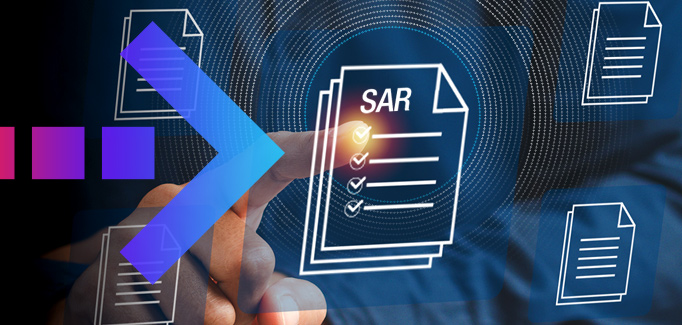Suspicious Activity Reports: It’s Why We Do What We Do
December 15th, 2021

We’ve covered the basics of what money laundering is and how it affects the global economy, as well as the origins of anti-money laundering and how a strong AML program can truly elevate the capabilities of any financial institution.
Now that we have a greater understanding of the foundations of AML, how does an investigator operate within a robust AML program and process any activity they deem suspicious. Fortunately, investigators can flag any activity they deem to be suspicious by filing a Suspicious Activity Report (SAR). Depending on your jurisdiction, SARS might also be referred to as Suspicious Transaction Reports (STRs) or Suspicious Matter Reports (SMRs).
Put simply, SARs are reports used by financial institutions to inform law enforcement agencies when they suspect activity represents money laundering or terrorist financing. In the U.S., legislation requiring the reporting of SARs was brought in by the Bank Secrecy Act (BSA) of 1970, and similar legislation covering SAR filing requirements was passed in other countries. SARs can cover almost any irregular activity where a customer may be attempting to hide illicit activity or make an illegal transaction. In 1996, SAR filing became the standard for financial institutions to report any suspicious activity. Outside of the U.S., SARs will be filed with each country’s respective financial intelligence unit (FIU).
Becoming much stricter after The Patriot Act in 2001, SAR requirements were significantly expanded as part of the effort to fight global and domestic terrorism, and most recently with the Anti-Money Laundering Act of 2020.
Thanks to accurate SARs, law enforcement can detect and investigate trends, illicit flows of funds and connections between organized crime groups. By detecting these patterns, they can anticipate and stop criminal activity and fraudulent behavior, recover the proceeds of crime and deny the criminals the profits of their crimes.
Suspicious Activity Report Filing Process for AML

Whenever any sort of suspicious activity is recorded with a US nexus, it’s filed with the Financial Crimes Enforcement Network (FinCEN), a division of the U.S. Treasury. FinCEN will then review the suspicious activity report and determine whether or not there are clearly identified offenses or whether there is sufficient intelligence to pursue an investigation.
Depending on the circumstances – branch location, customer account location and transaction activity – for when the suspicious activity occurred, FSOs might need to file a SAR in multiple jurisdictions. A platform in place that can handle situations like this is a must for any FI operating in multiple countries.
By law, customers should not be informed when a Suspicious Activity Report has been filed against them by a financial institution, and any disclosure of a filed report can lead to both the individual and the FI receiving severe fines or criminal action against them for tipping off.
Even though investigators are typically the individuals who experience and file the most SARs, an FI’s employees from any department can submit a report to FinCEN if they discover any suspicious activity.
Due to the regulations brought on by the BSA and later AML laws, there are multiple types of FIs that need to stay alert and on the lookout for suspicious activity to report:
- Banks and credit unions
- Check cashing companies and money order providers
- Casinos and card clubs
- Precious metals or gems dealers
- Insurance companies
- Mortgage businesses
Mortgage businesses If there is any sort of risk for money laundering, tax evasion or even criminal financing, by law the organization should be aware of the rules and regulations that come with SARs.
However, the ability to file SARs is not just limited to the employees of FSOs who are legally obligated. In fact, anyone in law enforcement, public safety, government officials, business owners and even those in the general public can submit a SAR within the United States. Whenever there is concern around financial matters, a SAR will circulate among the appropriate government agency via fusion centers, which allow information sharing between other agencies that might be affected by the flagged activity.
Suspicious Activity Report Filing Process for AML

Because of the risk posed to those who submit suspicious activity reports if their identity was ever leaked, SAR filing remains anonymous. Since the nature of the crimes more often than not lead to dealing with dangerous groups of people, having total anonymity in place protects the one who filed the SAR originally and stops the information from getting into the wrong hands.
Common activity that would warrant filing a SAR is as follows:
- Insider trading activity
- Potential money laundering or other violation of the BSA, such as odd, out-of-industry transactions
- Terrorism financing
- Computer hacking
- Unlicensed money services business operations
- Transactions made by those posing a higher risk, such as known connections to criminal organizations
- Law enforcement surveillance requests
When financial institutions report suspicious activity, all filings are required to be processed through FinCEN’s BSA e-file system to allow for standardization across the board, improving efficiency and shortening investigation times. There is a mandated 30-day window in which a SAR must be filed after point of detection. In the event of needing more evidence, an extension of an additional 30 days is available. For an FSO, failure to comply leads to civil and criminal penalties, substantial fines, regulatory restrictions, loss of banking charter and even imprisonment.
A Suspicious Activity Report will need to fill in five sections of information and go through this reporting process:

Basic background
Names, addresses, social security numbers, birth dates, drivers licenses or passports, occupations and the phone numbers of all the involved parties of the incident
Incident dates
To allow investigators to focus solely on the activity at hand, they will need to have the date range of when the incident started and when it ended, if it hasn’t already
FI background
Basic information regarding the FI where the activity occurred. This includes insurance, accounting, banking, brokerage, risk analysis, asset management, and investment.
FI contact info
For the investigators to do their due diligence while investigating, the contact info of the relevant parties within the FI are required
Activity details
The most important information on the form, by providing a detailed description of the activity, a reporter can share why the SAR was filed and explain what made them suspicious the activity was illicit
Proper SAR usage is vital for the continuous protection of both the individual FI affected, as well as the overall global economy. By quickly bringing potentially suspicious activity to the attention of law enforcement or government agencies, one can limit the damage of financial crime or prevent large transactions, and for FIs, proper SAR filings can limit severe penalties imposed on those who don’t follow the rules and regulations.
For more information on fighting money laundering, click here.




